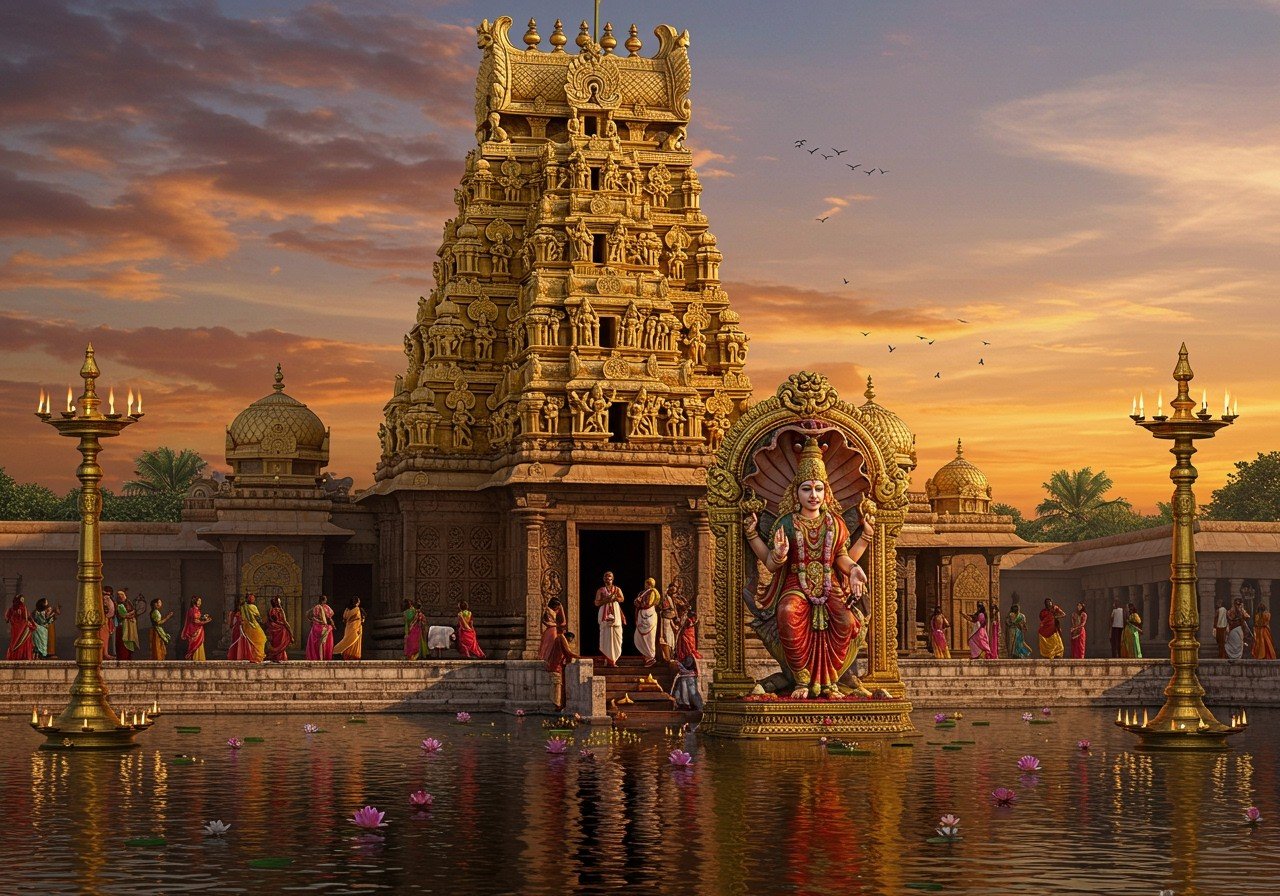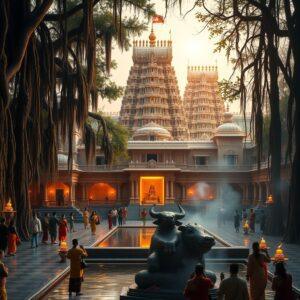
The Lakshmi Narasimha temples of South India stand as magnificent examples of architectural prowess and spiritual dedication. These temples, dedicated to the half-man, half-lion avatar of Lord Vishnu, Lakshmi Narasimha, are not only places of worship but also marvels of ancient engineering and art. This article explores the intricate architecture, historical significance, and cultural importance of these revered temples.
Historical Background
To understand the significance of the Lakshmi Narasimha temples, it’s essential to delve into their historical context. Many were constructed during the reigns of powerful dynasties like the Pallavas, Cholas, and Vijayanagaras, each contributing to the evolution of Dravidian architecture. These dynasties championed Vaishnavism, leading to the creation of grand temples dedicated to Lord Vishnu. Key figures like Raja Raja Chola I (around 10th-11th century CE) actively supported temple construction, reflecting the socio-political landscape of their time.
Architectural Features
Lakshmi Narasimha temples are renowned for their architectural brilliance. Common features include:
- Gopurams: These towering gateways serve as impressive entrances, often adorned with intricate sculptures and vibrant colors. They mark the transition from the mundane to the sacred.
- Mandapas: These pillared halls provide spacious areas for devotees to gather, pray, and witness rituals. The pillars often feature elaborate carvings depicting mythological scenes and divine figures.
- Vimanas: These soaring towers rise above the sanctum sanctorum, symbolizing the temple’s connection to the heavens. Their shape and ornamentation vary depending on the specific architectural style.
Intricate carvings adorn the temple walls, depicting scenes from Hindu mythology, particularly those related to the Narasimha avatar. Temples were constructed using durable materials like granite and sandstone. The layout typically includes the garbhagriha (sanctum sanctorum) where the deity resides and the pradakshina patha (circumambulatory path) for devotees to perform ritual circumambulation. Notable examples include the Lakshmi Narasimha Temple in Yadadri, Telangana, and the Varadaraja Perumal Temple in Kanchipuram, Tamil Nadu.
Symbolism and Iconography
The iconography within Lakshmi Narasimha temples is rich in symbolism. Lord Narasimha is depicted in various forms, including Ugra Narasimha (his fierce form) and Yoga Narasimha (his meditative form), each holding profound spiritual meaning for devotees. Other deities and mythical creatures, such as Garuda (Lord Vishnu’s eagle mount) and Alwars (Vaishnavite saints), frequently appear in the carvings. Architectural elements like lotus motifs and sacred geometry contribute to the temple’s spiritual significance. Temple rituals are intertwined with the architecture, creating a sacred space for worship and devotion.
Cultural and Religious Importance
Lakshmi Narasimha temples are vibrant centers of cultural and religious activity. Festivals like Narasimha Jayanti and Brahmotsavam are celebrated with great enthusiasm, often featuring traditional art forms like Bharatanatyam dance and Carnatic music. Prasad (sanctified food) offerings are an integral part of temple worship, symbolizing blessings and devotion. These temples also serve as important venues for social gatherings and charitable activities, strengthening community bonds.
Case Studies of Prominent Temples
Sri Lakshmi Narasimha Swamy Temple, Ahobilam
Located in Andhra Pradesh, this temple complex houses nine shrines dedicated to different forms of Lord Narasimha. Each shrine is a testament to the architectural and devotional richness of the region.
Lakshmi Narasimha Temple, Hampi
This UNESCO World Heritage Site in Karnataka showcases the grandeur of Vijayanagara architecture. Its intricate carvings and impressive structure draw visitors from around the world.
Simhachalam Temple, Visakhapatnam
This temple features a unique blend of Chalukyan and Orissan architectural styles, reflecting the diverse cultural influences in Andhra Pradesh.
Narasimha Temple, Sholingur
Located in Tamil Nadu, this ancient temple holds significant historical importance and remains a popular pilgrimage site for devotees seeking Lord Narasimha’s blessings.
Preservation and Conservation Efforts
Preserving these architectural marvels is vital. Organizations like the Archaeological Survey of India (ASI) play a crucial role in maintaining these heritage sites. However, challenges such as environmental degradation and urbanization pose ongoing threats. Local communities and temple management actively participate in conservation efforts. Modern technologies, including 3D scanning and digital archiving, aid in documenting and preserving these cultural treasures for future generations. Public awareness and education are essential to ensure the continued protection of these landmarks.
Poojn.in: Your Partner in Devotion
Poojn.in, India’s leading online store for spiritual and cultural goods, offers a wide selection of items to enhance your worship experience. Whether you’re seeking puja samagri, deity idols, or other religious artifacts, Poojn.in provides high-quality products delivered conveniently to your doorstep. Explore our collection today and enrich your spiritual journey.
- Find authentic puja items for Lakshmi Narasimha worship here.
- Browse our collection of brass and copper items here.
Conclusion
The Lakshmi Narasimha temples are not merely structures of stone and mortar; they are living embodiments of South India’s rich spiritual and cultural tapestry. Their history, architecture, symbolism, and vibrant cultural activities make them invaluable treasures. By visiting and supporting these sacred sites, we contribute to the preservation of our heritage for generations to come. Embrace the opportunity to learn more and plan your visit to these magnificent temples, allowing their awe-inspiring beauty and profound devotion to enrich your life.
FAQs about Lakshmi Narasimha Temples
What makes the Lakshmi Narasimha Temple in Antarvedi unique? The temple’s location at the meeting point of the Bay of Bengal and the Vasishta Godavari River is geographically significant. It is dedicated to Lord Narasimha, a powerful incarnation of Vishnu.
What are some notable architectural features of the Antarvedi temple? The five-tiered gopuram and intricate carvings of deities and mythological scenes are highlights of the temple’s Dravidian architecture.
Where can I find pictures of the Antarvedi temple? Numerous travel websites, temple-related platforms, and social media posts showcase images of the Lakshmi Narasimha Temple in Antarvedi.
What is the significance of the Lakshmi Narasimha Temple in Mangalagiri? As one of the Pancha Narasimha Kshetrams, this temple is known for its hilltop location and the unique tradition of the deity seemingly consuming half of the jaggery offerings.
How do I get to the Lakshmi Narasimha Temple in Antarvedi? The temple is accessible by road from Rajahmundry and Amalapuram. Narasapur is the closest railway station, and Rajahmundry Airport is the nearest airport.
Are there any special festivals celebrated at Lakshmi Narasimha Temples? Brahmotsavam, a major festival with rituals and processions, is celebrated with great fervor at both the Antarvedi and Mangalagiri temples.
When is the ideal time to visit the Antarvedi temple? The winter months (October to March) offer pleasant weather for visiting the Lakshmi Narasimha Temple in Antarvedi.
Are there places to stay near the Mangalagiri temple? Yes, various hotels, guest houses, and temple-run accommodations are available for devotees visiting the Lakshmi Narasimha Temple in Mangalagiri.


